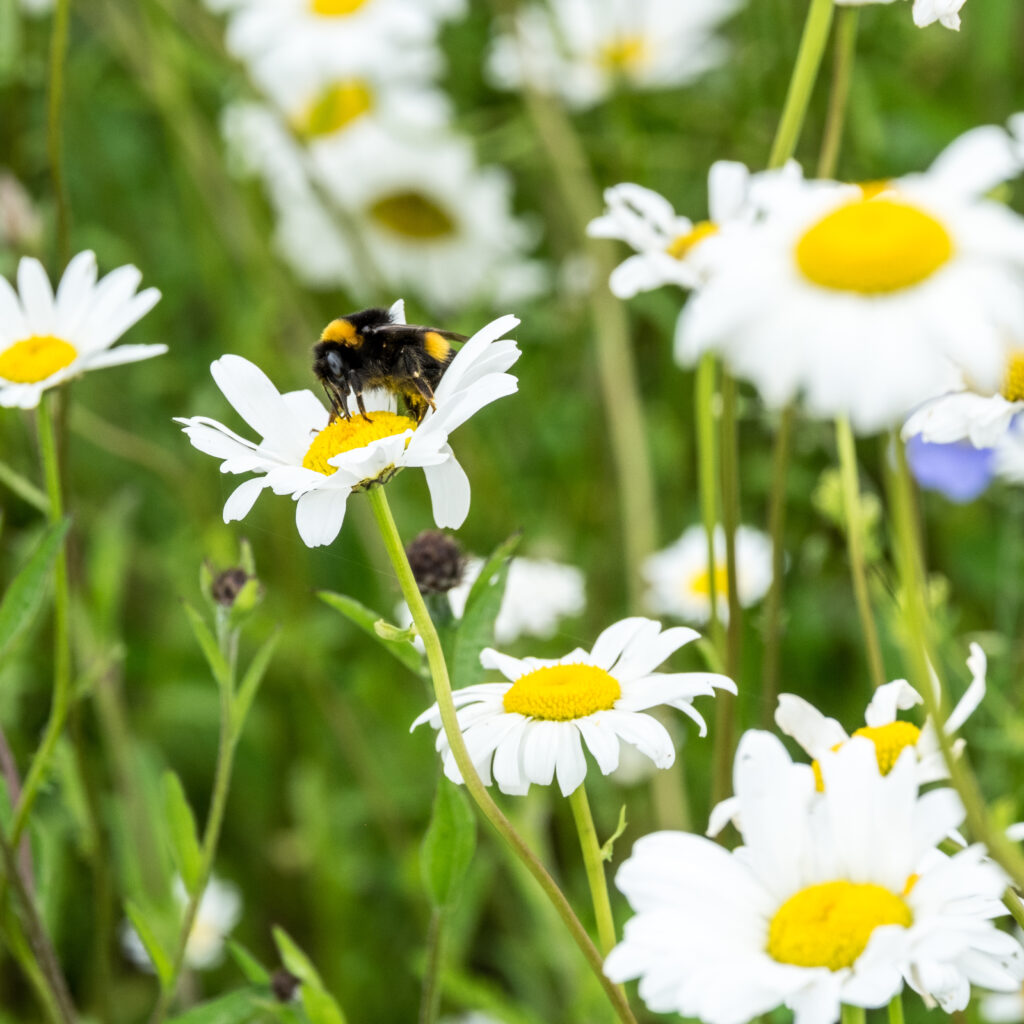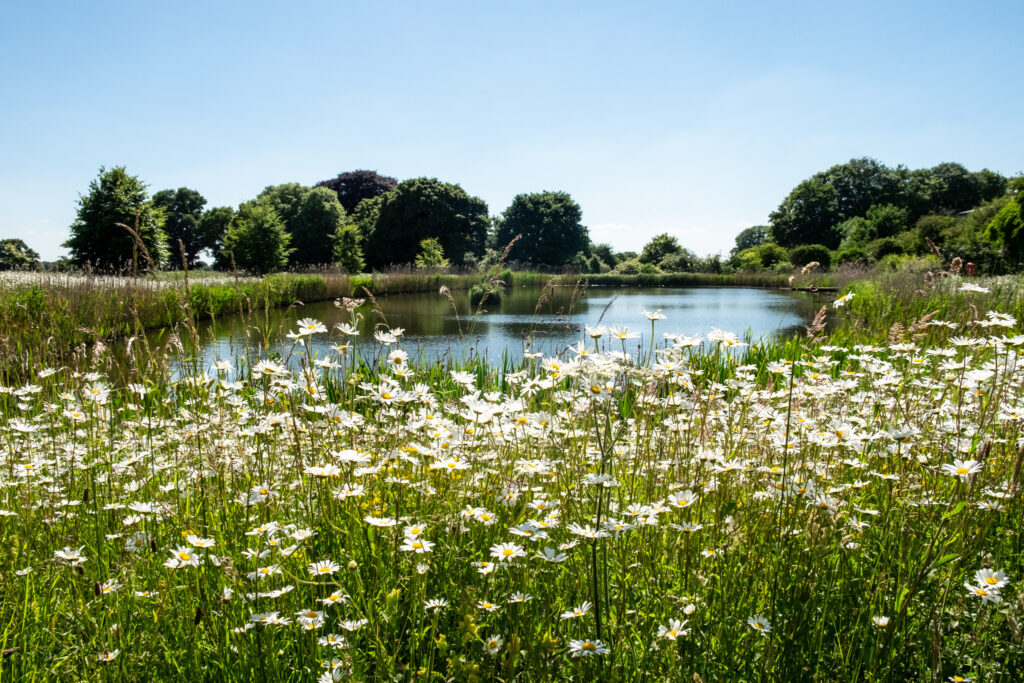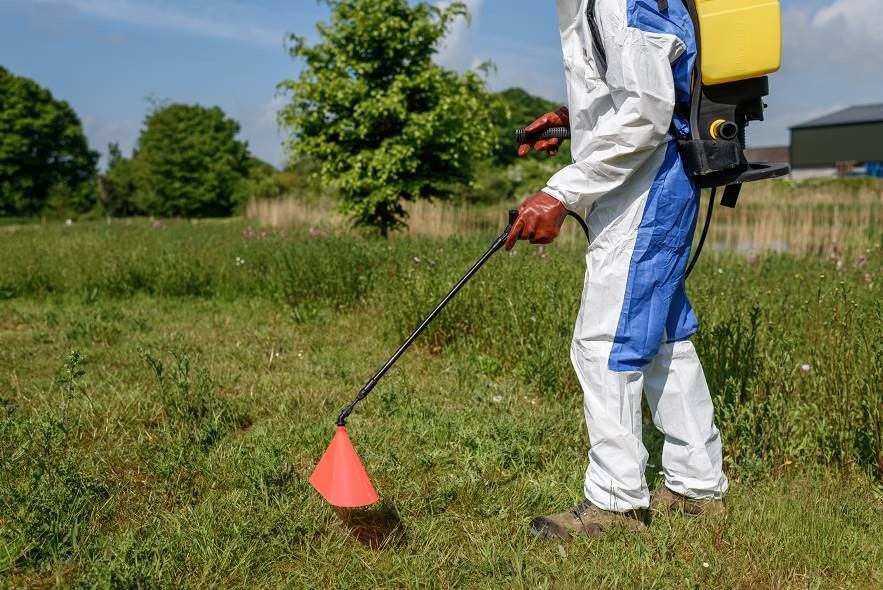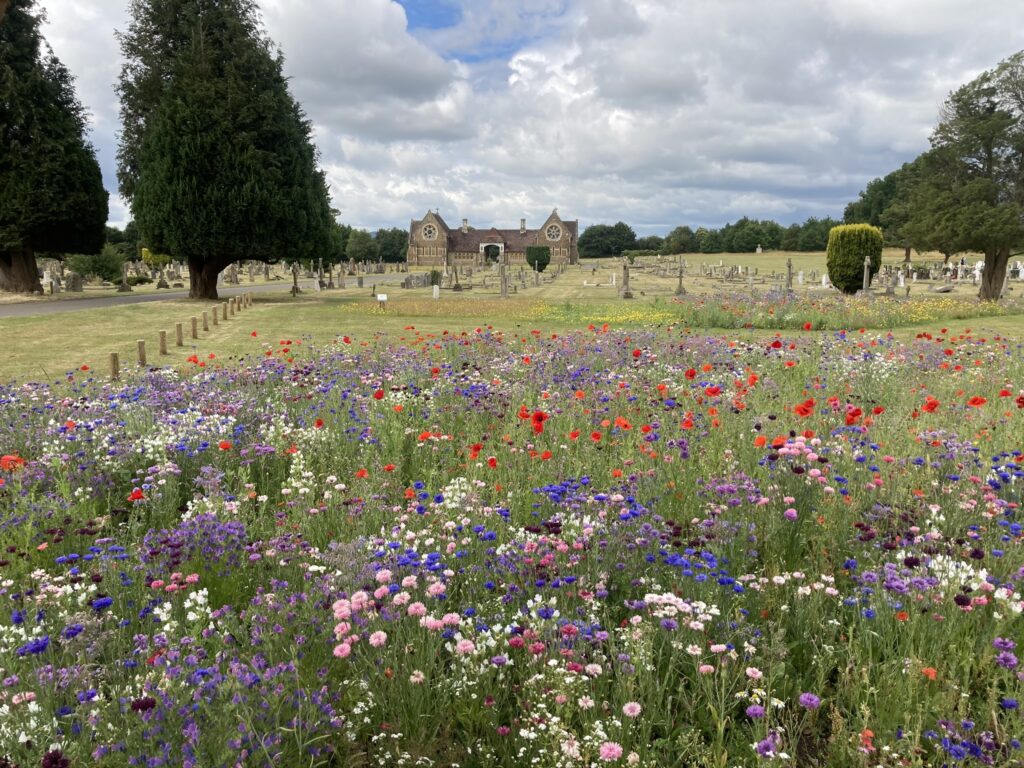The great glyphosate debate: an in-depth look into the science behind this controversial herbicide, including our stance on its use for wildflower spaces from the research & development team at Wildflower Turf.
It’s no secret that glyphosate, also known as Roundup, has a bit of a chequered past and it has certainly had its fair share of newspaper column space over the last few years. So it might seem odd to you that we are still recommending its use in certain circumstances, but Helen from our research & development team is here to delve into the science behind it and explain why it’s still one of our recommended options for creating biodiverse wildflower spaces.
Firstly, a little background information
Glyphosate is an organophosphate herbicide, or weedkiller, that was developed by the agrochemical giant Monsanto (since bought out by Bayer) in the 1970s.1 It was originally marketed as an agricultural weed control method, and its impact on agriculture was so profound that it has been described “as important for reliable global food production as penicillin is for battling disease”. 2 It quickly became the most used herbicide in the US agricultural sector, and its trade name, Roundup, became synonymous with effective weed control in a wide range of applications.
The science behind the name.
The way that glyphosate works is to inhibit enzymes in plants that promote protein creation, which essentially means it completely prevents plants from being able to grow. Because of this, it is mainly effective on the leaf and stem, and only works on plants that are actively growing, stopping growth within hours of application. It is often mixed with additives such as surfactants, that help it bind to and penetrate the leaf surface. Glyphosate is effective in a variety of plants, including grasses, broadleaf plants and shrubs.3 The enzyme that it blocks does not exist in humans and animals.4
After use, glyphosate will end up in the soil as its molecular structure bonds strongly to soil particles. This structure means it does not readily wash away and enter water courses, and it is quickly digested by soil microbes.5
Is there cause for concern when it comes to glyphosate?
Much of the reason that glyphosate (or Roundup) is so well known is that it has featured in the news quite a bit over the last few years because of claims of its toxicity to humans, as well as other organisms. Opinions on its use remain divided, and legislature is still being debated.
For example, there is some evidence that it may cause harm to bees and other invertebrates as well as aquatic ecosystems, 6,7,8 but there is a lot of conflicting evidence around its purported ecotoxicity and what doses or additives are required for it to become problematic.9

In terms of human toxicity, the main cause for concern has been reports that markers of cancer may be caused by exposure to glyphosate.10,11 This has featured a lot in the news as various lawsuits have been filed against Bayer, which bought Monsanto in 2018, in the US, alleging that cancers such as non-Hodgkin’s lymphoma had been caused by the use of Roundup. Many cases are still ongoing.12
This might seem rather damning to our case for the use of glyphosate, but if you look a little deeper at the science behind the news stories you can see that there is a lot more to it. The problem is that there are a number of studies appearing to show that labelled uses of glyphosate are not harmful to humans and other organisms,13,14,8 and a number of studies that appear to show that it is damaging.15,11 The International Agency for Research on Cancer deemed glyphosate a probable human carcinogen in 2015,16 while the European Chemicals Agency concluded that it was not carcinogenic in May 2022.8 Importantly, glyphosate remains approved for use in the UK and EU until 2025, though many councils have banned its use in favour of pesticide-free options such as acetic acid and hot foam applications.
This lack of consensus means that we should err on the side of caution when it comes to using this product. No-one is recommending you go out and douse your entire garden, street or local park (and in the process, yourself, your neighbours and your pet cat or dog) in glyphosate on a regular basis, as used indiscriminately it is possible it will have an adverse effect on the natural environment and human health. But there is evidence that in small amounts, applied safely, it may actually be beneficial for promoting species rich, biodiverse environments by enabling easy removal of invasive, non-native plants that can then be replaced with a more species rich, native habitat.17 This kind of minimal use, where no alternative is available or appropriate, is what’s recommended for our purposes.

Costs and benefits
The potential costs of using glyphosate must be balanced with the benefits, which in agricultural terms are increases in crop yield and reductions in carbon emissions.18 The horticultural costs and benefits must be assessed in much the same way.
Our main concern, as a business with improving biodiversity at its heart, is that our products are successful – we need our customers to be happy with their wildflower spaces, and we need them to be biodiverse, species rich, carbon sequestering, soil improving, sustainable spaces that will last way into the future. One of the major barriers that we have found to achieving this is weed ingress, and the best way to eliminate this barrier in most cases is to thoroughly remove existing vegetation prior to installing a wildflower space. And in some cases, the easiest, cheapest, least time consuming, and most effective method to ensure ultimate success of the meadow is to use an herbicide prior to installation.
In an ideal world, we would like to be able to recommend an organic, toxin-free, natural weed removal option, and in fact we often do: we want to work with nature, not against it. But the fact of the matter is that other methods of removing weeds are often simply not as effective and are often not that sustainable either. In a study by Cardiff County Council in conjunction with Swansea University, glyphosate was compared with two increasingly popular options, touted as more ‘environmentally friendly’: acetic acid and hot foam application.19 They found glyphosate to be the least expensive product used and it also ranked highest for customer satisfaction. Dr Dan Jones who conducted the study said: “Once you look at the full life cycle of the product, factoring in things like the amount of fuel and water used, it is also the least damaging to the environment”.20 So, when weighing up the costs and benefits on a case-by-case basis, sometimes glyphosate comes out on top.

The most sustainable option
We pride ourselves on being well informed here at Wildflower Turf and every decision we make is carefully considered and backed up by extensive research, and we always hold our commitment to doing our best to be as sustainable and environmentally friendly as possible at the forefront of our decision making. It is because of this that we currently believe that in some cases, where other methods are not viable, glyphosate is the most sustainable option for weed control when used responsibly and in a targeted manner. Having said that, we are always on the lookout for the latest methods and scientific research on this and many other topics, so our position is always subject to change. Follow our blog to stay up to date with all the latest developments in Wildflower Turf R&D.
Take a look at a recent case study where glyphosate was used effectively to install a peat-free, plastic-free, biodiverse wildflower space, replacing a grassy sward at Eashing Cemetery.

References
[1] Duke, S.O. & Powles, S.B. (2008) ‘Glyphosate: a once-in-a-century herbicide: Mini-review’, Pest Management Science, vol. 64 (4), pp. 319 – 25. DOI: 10.1002/ps.1518 [Accessed 15/02/2023]
[2] Powles, S. (2010) ‘Gene amplification delivers glyphosate-resistant weed evolution’, Proceedings of the National Academy of Sciences, vol. 107 (3) pp. 955 – 956. Available at: Gene amplification delivers glyphosate-resistant weed evolution – Australian Herbicide Resistance Initiative (AHRI) (uwa.edu.au) [Accessed 15/02/2023]
[3] Dill, G.M., Sammons, R.D., Feng, P.C., Kohn, F., Kretsmer, K., Mehrsheikh, A., Bleeke, M., Honegger, J.L., Farmer, D., Wright, D. & Haupfear, E.A. (2010) ‘Glyphosate: Disovery, Development, Applications and Properties’ (PDF). In Nandula, V.K. (ed) Glyphosate Resistance in Crops and Weeds: History, Development and Management. Hoboken, N.J: Wiley. ISBN 978-0-470-41031-8. Available at: c01.indd (johnwiley.com.au) [Accessed 15/02/2023]
[4] Maeda, H. & Dudareva, N. (2012) ‘The shikimate pathway and aromatic amino acid biosynthesis in plants’, Annual Review of Plant Biology, vol. 63, pp. 73 – 105. DOI: 10.1146/annurev-arplant-042811-105439 [Accessed 15/02/2023]
[5] Duke, S.O. (2020) ‘Glyphosate: environmental fate and impact’, Weed Science, vol. 68 (3), pp. 201 – 207. DOI: https://doi.org/10.1017/wsc.2019.28 [Accessed 14/02/2023]
[6] Tan, S., Li, G., Liu, Z., Wang, H., Guo, X. & Xu, B. (2022) ‘Effects of glyphosate exposure on honeybees’, Environmental Toxicology and Pharmacology, Vol. 90. DOI: https://doi.org/10.1016/j.etap.2021.103792 [Accessed 14/02/2023]
[7] Weidenmuller, A., Meltzer, A., Neupert, S., Schwarz, A. & Kleineidam, C. (2022) ‘Glyphosate impairs collective thermoregulation in bumblebees’, Science, vol. 376 (6597), pp. 1122 – 1126. DOI: 10.1126/science.abf7482 [Accessed 14/02/2023]
[8] ECHA (2017) ‘Glyphosate not classified as a carcinogen by ECHA’, ECHA, March 15. Available at: All news – ECHA (europa.eu) [Accessed 15/02/2023]
[9] Moser, V.C., Morris-Schaffer, K., Richardson, J.R. & Li, A.A. (2022) ‘Glyphosate and neurological outcomes: a systematic literature review of animal studies’, Journal of Toxicology and Environmental Health, Part B, vol. 25 (4), pp. 162 – 209. DOI: https://doi.org/10.1080/10937404.2022.2083739 [Accessed 14/02/2023]
[10] Chang, V.C., Andreotti, G., Ospina, M., Parks., C.G., Liu, D., Shearer, J.J., Rothman, N., Silverman, D.T., Sandler, D.P., Calafat, A.M., Beane Freeman, L.E. & Hofmann, J.N. (2023) ‘Glyphosate exposure and urinary oxidative stress biomarkers in the Agricultural Health Study’, Journal of the National Cancer Institute, vol. 242. DOI: https://doi.org/10.1093/jnci/djac242 [Accessed 14/02/2023]
[11] Cressey, D (2015) ‘Widely used herbicide linked to cancer’ Nature. DOI: 10.1038/nature.2015.17181 [Accessed 15/02/2023]
[12] Gillam, C. & Uteuova, A. (2022) ‘Popular weedkiller Roundup on trial again as cancer victims demand justice’, The Guardian, Tuesday 23 August. Available at: Popular weedkiller Roundup on trial again as cancer victims demand justice | Monsanto | The Guardian [Accessed 14/02/2023]
[13] Rodriguez-Gil, J.L., Prosser, R.S., Duke, S.O. & Solomon, K.R. (2021) ‘Ecotoxicology of glyphosate, its formulants, and environmental degradation products’, Review of Environmental Contaminant Toxicology, vol. 255, pp. 129 – 205. DOI: 10.1007/398_2020_56 [Accessed 14/02/2023]
[14] Tarazona, J.V., Court-Marques, D., Tiramani, M., Reich, H., Pfeil, R., Istace, F. & Crivellente, F. (2017) ‘Glyphosate toxicity and carcinogenicity: a review of the scientific basis of the European Union assessment and its differences with IARC’, Archives of Toxicology, vol. 91 (8), pp. 2723 – 43. DOI: 10.1007/s00204-017-1962-5 [Accessed 15/02/2023]
[15] Peillex, C. & Pelletier, M. (2020) ‘The impact and toxicity of glyphosate and glyphosate-based herbicides on health and immunity’, Journal of Immunotoxicology, vol. 17 (1), pp. 163 – 174. DOI: DOI: 10.1080/1547691X.2020.1804492 [Accessed 14/02/2023]
[16] IARC (2015) ‘Press release: IARC Monographs Volume 112: evaluation of five organophosphate insecticides and herbicides’, International Agency for Research on Cancer, World Health Organisation (PDF). Available at: IARC Monographs Volume 112: evaluation of (who.int) [Accessed 15/02/2023]
[17] Nyamai, P.A., Prather, T.S. & Wallace, J.M. (2011) ‘Evaluating restoration methods across a range of plant communities dominated by invasive annual grasses to native perennial grasses’ Invasive plant science and management, vol. 4 (3) pp. 306 – 16. DOI: 10.1614/IPSM-D-09-00048.1 [Accessed 15/02/2023]
[18] Wynn, S. & Webb, E. (2022) ‘Impact assessment of the loss of glyphosate within the EU: a literature review’, Environmental Sciences Europe, vol. 34 (91). DOI: https://doi.org/10.1186/s12302-022-00667-3 [Accessed 14/02/2023]
[19] Advanced Invasives for Cardiff Council (2021) Weed Control Trial 2021: Final Project Report. Available at: Item 3 – Appendix A.pdf (moderngov.co.uk) [Accessed 15/02/2023]
[20] Hortweek (2023) ‘Council trial finds glyphosate “most sustainable weed control”,’ Hortweek, 13 January 2023. Available at: Council trial finds glyphosate ‘most sustainable weed control’ | HortWeek [Accessed 15/02/2023]